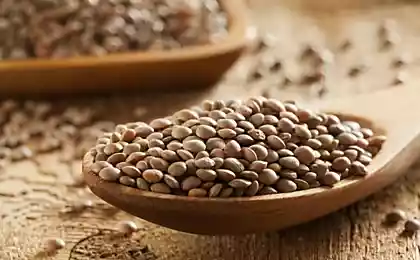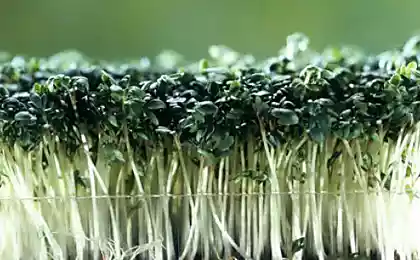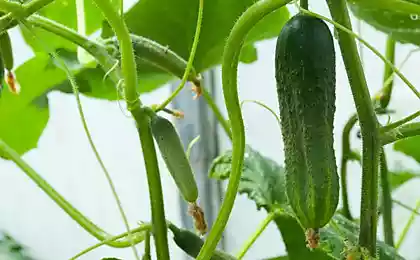239
What is useful lentils, and how to grow it?
Lentils are not just a plant of the Bean family, but a whole legend. Biblical history says that one brother - Esau - for a plate of delicious lentil soup sold to another brother - Jacob - his birthright, which in Israel was considered sacred and passed on with a huge share of inheritance. Is lentils really that good? Yes, it is not only delicious, but also very useful! No wonder the French, subtle connoisseurs of tasty and healthy food, always include it in their diet.
Features of lentils - cute herbaceous annual height from 15 to 70 cm. Its edible beans vary in color and are black, brown, green and red (depending on the variety). Lentils have a unique feature: it is not able to accumulate nitrates and radionuclides, so even grown in contaminated areas, is always an environmentally friendly product.
Queen of legumes is very unpretentious and is able to tolerate short-term (up to -5 degrees) frost during the growing season. It also withstands a prolonged drought due to a strongly branched rod root, quite powerful for such a baby. The unique drought tolerance of lentils made it famous when, in 1891-1892, it saved Russia from unprecedented famine during a drought. At that time, most of the cultivated plants died, but the lentils survived.
The thin, strongly branched stem of the plant is strewn with paropier leaves. In the period of full development, it looks like a fluffy bush, erect or half-standing, capable of giving tasty and healing beans that we enjoy eating. By the size of the bean, lentils are divided into large-seed, small-seed and plate. Small seed - the most unpretentious and drought-resistant.
The lentil bush looks very aesthetically pleasing during the flowering period - all in the halo of small five-petaled flowers of various shades (depending on the variety), which modestly look out of the sinuses of green leaves. Many types of lentils are self-pollinating, only in rare varieties of it cross-pollination.
Therapeutic and nutritional qualities of lentils are therapeutic, they are widely used in folk medicine. Infusions and decoctions of lentils help with poisoning and lung diseases. Pure from it is recommended for colitis and stomach diseases. The decoction is able to remove toxins from the body and has antitumor activity. And if you want to lose weight, be sure to include lentils in the diet! The result will not take long to wait, since it is low-calorie, rich in fiber, and even its small portions can cause rapid saturation.
From lentils you can cook almost everything, from delicious soups and healing bread, ending with pilaf and cutlets. And some particularly exquisite cooks manage to make even candy from it. Lentils are perfectly combined with fish, eggs, meat, greens and can serve as a wonderful side dish. Especially tasty and saturated with vitamins lentil porridge, which has a beneficial effect on metabolism, strengthens the heart system and blood vessels. Moreover, this amazingly healing plant retains its properties even after heat treatment.
Lentils are rich in amino acids, iron, B vitamins and are one of the few foods to which our body is perfectly adapted genetically. For all these unique properties, she is deservedly called the bean queen. How can you not grow such a useful plant in the country? Let's put him down!
Planting lentils is unpretentious, but has its own preferences. He likes well-fertilized loose loamy or sandy soils. It grows quite normally on heavy soils, but you will not get a good harvest in such conditions. In addition, the plant very poorly perceives acidified soils. If you have any of them, then make sure you have them. Lentils are better planted in an open sunny place, in the shade it is less productive. Very good for her land, where last year grew potatoes, corn or winter crops.
So, we decided on a place to plant lentils. Now add 50-60 grams of phosphate and potash fertilizers to each square meter of soil. Fertilizers are applied for autumn or spring digging - at your discretion. Start sowing in early spring, when the ground thaws 15-20 cm deep. Before sowing for a day, soak the seeds in an epin solution: 2 drops per 100 ml of water - this will increase the yield of the crop by 10-15%. After soaking, immediately before planting, dry the seeds and sow them in grooves 4-5 cm deep; the distance between them make 12-15 cm. Then bury the grooves and carefully tamp them with your hands.
When in a couple of weeks the lentils germinate massively, it is necessary to clear the rows, otherwise there is a danger that the weeds will clog the sprouts. Arrowing is best done at noon. For the first month and a half, lentils grow slowly, gaining strength for future flowering. But after it fades, it begins a period of intensive growth and branching. At this time, it turns into charming fluffy bushes, from which you will gather a healing harvest in August-September. Just keep in mind that the maturation of lentils occurs unevenly. First, the beans ripen on the lower parts of the bush, and a little later on the upper ones.
Although lentils are resistant to drought, for 1.5 months after planting, the soil should be regularly moistened, preventing drying out. And when it gains strength, you can water it 2-3 times a week on especially dry days. If your site is rich in weeds, you need to regularly weed between rows. That's all the care.
The most popular varieties of lentils Laird
Lentils "Laird" - large-seeded high-yielding variety of medium maturation. The period from sowing to the first harvest is 2.5-3 months. Beans of large size, round, slightly convex shape, up to 7 mm in diameter. It has a very pleasant rich taste, and even after long cooking retains its shape.
Puy lentil variety (French lentils)
Lentils of the variety "Puy" has an interesting "marble" pattern and fragrant, slightly spicy taste. It does not boil, but during heat treatment it becomes unusually soft, so it is often used to make salads. The variety is medium-ripe, not particularly frost-resistant and, perhaps, the most delicious of all other varieties of lentils. It is this variety that the French prefer, serving lentil dishes to their table.
Beluga lentil variety
Beluga lentils have the smallest grains of all others. They are black and very similar to beluga caviar - hence, in fact, the name. It has a delicate spicy aroma, and is cooked much faster than other varieties of lentils. The variety is early ripe and relatively frost-resistant.
This wonderful and unpretentious plant can be easily grown in your country. Lentils are not as popular among Russian summer residents as peas and beans, for example, but it is much healthier and tastier. The taste and color, as they say... I really like lentils, don't you?
Source: www.7dach.ru
Features of lentils - cute herbaceous annual height from 15 to 70 cm. Its edible beans vary in color and are black, brown, green and red (depending on the variety). Lentils have a unique feature: it is not able to accumulate nitrates and radionuclides, so even grown in contaminated areas, is always an environmentally friendly product.
Queen of legumes is very unpretentious and is able to tolerate short-term (up to -5 degrees) frost during the growing season. It also withstands a prolonged drought due to a strongly branched rod root, quite powerful for such a baby. The unique drought tolerance of lentils made it famous when, in 1891-1892, it saved Russia from unprecedented famine during a drought. At that time, most of the cultivated plants died, but the lentils survived.
The thin, strongly branched stem of the plant is strewn with paropier leaves. In the period of full development, it looks like a fluffy bush, erect or half-standing, capable of giving tasty and healing beans that we enjoy eating. By the size of the bean, lentils are divided into large-seed, small-seed and plate. Small seed - the most unpretentious and drought-resistant.
The lentil bush looks very aesthetically pleasing during the flowering period - all in the halo of small five-petaled flowers of various shades (depending on the variety), which modestly look out of the sinuses of green leaves. Many types of lentils are self-pollinating, only in rare varieties of it cross-pollination.
Therapeutic and nutritional qualities of lentils are therapeutic, they are widely used in folk medicine. Infusions and decoctions of lentils help with poisoning and lung diseases. Pure from it is recommended for colitis and stomach diseases. The decoction is able to remove toxins from the body and has antitumor activity. And if you want to lose weight, be sure to include lentils in the diet! The result will not take long to wait, since it is low-calorie, rich in fiber, and even its small portions can cause rapid saturation.
From lentils you can cook almost everything, from delicious soups and healing bread, ending with pilaf and cutlets. And some particularly exquisite cooks manage to make even candy from it. Lentils are perfectly combined with fish, eggs, meat, greens and can serve as a wonderful side dish. Especially tasty and saturated with vitamins lentil porridge, which has a beneficial effect on metabolism, strengthens the heart system and blood vessels. Moreover, this amazingly healing plant retains its properties even after heat treatment.
Lentils are rich in amino acids, iron, B vitamins and are one of the few foods to which our body is perfectly adapted genetically. For all these unique properties, she is deservedly called the bean queen. How can you not grow such a useful plant in the country? Let's put him down!
Planting lentils is unpretentious, but has its own preferences. He likes well-fertilized loose loamy or sandy soils. It grows quite normally on heavy soils, but you will not get a good harvest in such conditions. In addition, the plant very poorly perceives acidified soils. If you have any of them, then make sure you have them. Lentils are better planted in an open sunny place, in the shade it is less productive. Very good for her land, where last year grew potatoes, corn or winter crops.
So, we decided on a place to plant lentils. Now add 50-60 grams of phosphate and potash fertilizers to each square meter of soil. Fertilizers are applied for autumn or spring digging - at your discretion. Start sowing in early spring, when the ground thaws 15-20 cm deep. Before sowing for a day, soak the seeds in an epin solution: 2 drops per 100 ml of water - this will increase the yield of the crop by 10-15%. After soaking, immediately before planting, dry the seeds and sow them in grooves 4-5 cm deep; the distance between them make 12-15 cm. Then bury the grooves and carefully tamp them with your hands.
When in a couple of weeks the lentils germinate massively, it is necessary to clear the rows, otherwise there is a danger that the weeds will clog the sprouts. Arrowing is best done at noon. For the first month and a half, lentils grow slowly, gaining strength for future flowering. But after it fades, it begins a period of intensive growth and branching. At this time, it turns into charming fluffy bushes, from which you will gather a healing harvest in August-September. Just keep in mind that the maturation of lentils occurs unevenly. First, the beans ripen on the lower parts of the bush, and a little later on the upper ones.
Although lentils are resistant to drought, for 1.5 months after planting, the soil should be regularly moistened, preventing drying out. And when it gains strength, you can water it 2-3 times a week on especially dry days. If your site is rich in weeds, you need to regularly weed between rows. That's all the care.
The most popular varieties of lentils Laird
Lentils "Laird" - large-seeded high-yielding variety of medium maturation. The period from sowing to the first harvest is 2.5-3 months. Beans of large size, round, slightly convex shape, up to 7 mm in diameter. It has a very pleasant rich taste, and even after long cooking retains its shape.
Puy lentil variety (French lentils)
Lentils of the variety "Puy" has an interesting "marble" pattern and fragrant, slightly spicy taste. It does not boil, but during heat treatment it becomes unusually soft, so it is often used to make salads. The variety is medium-ripe, not particularly frost-resistant and, perhaps, the most delicious of all other varieties of lentils. It is this variety that the French prefer, serving lentil dishes to their table.
Beluga lentil variety
Beluga lentils have the smallest grains of all others. They are black and very similar to beluga caviar - hence, in fact, the name. It has a delicate spicy aroma, and is cooked much faster than other varieties of lentils. The variety is early ripe and relatively frost-resistant.
This wonderful and unpretentious plant can be easily grown in your country. Lentils are not as popular among Russian summer residents as peas and beans, for example, but it is much healthier and tastier. The taste and color, as they say... I really like lentils, don't you?
Source: www.7dach.ru























